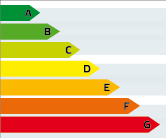Energy performance certificate
An energy performance certificate provides information on the building's energy consumption.
What is the purpose of an energy performance certificate?
The energy performance certificate is intended for people who are planning to purchase or rent a building or a part of a building, and also for those who visit larger buildings frequently visited by the public. It can be used to compare different buildings with each other. It is the responsibility of the owner of the building to show the energy performance certificate.
Who should produce an energy performance certificate and when it should be done
The energy performance certificate should always be produced by an independent certified energy expert upon request by the owner of the building. The certificate is valid for ten years.
The owner has to engage a certified energy expert to carry out an energy performance certificate:
- prior to a sale issued
- in connection with renting
- for larger buildings frequently visited by the public
- for new buildings.
The certificate for new buildings must be done not later than two years after the building has been put in use. If the building is being sold, rented out or has frequently been visited by the public within the last two years, the building should have an energy performance certificate.
The developer is responsible for establishing an energy performance certificate for a new building. The certificate shows if the building has the energy quality that was intended for the building.
What does an energy performance certificate contain?
The performance certificate contains information about:
- the heated area of the building
- energy consumption for heating, comfort cooling, hot tap water and the property electricity in the building
- energy performance
- energy requirement for a new building
- the building's heating and ventilation systems
- if obligatory ventilation control has been approved (OVK)
- if radon measurement has been performed, and if so, the determined level.
The certificates also contain other information, such as suggested measures, if the energy expert has given any, to reduce energy consumption.
Energy performance measures
Energy consumption is described in the energy performance certificate in terms of energy performance measures. Energy performance measures indicate how much energy is consumed by heating, air-conditioning, hot tap water and the building's property electricity. All energy consumed for this in one entire year is aggregated and divided by the heated surface of the building. The result is the number of kilowatt-hours (kWh) used per square meter (m2). Energy performance is expressed in terms of the unit kWh/m2 and year.
Energy classes from A to G
Energy classification is included in the certificates to make it easier to compare buildings with each other and to get an idea of their energy consumption. Energy Class A stands for low energy consumption, and G stands for high. A building that has an energy consumption corresponding to the requirement imposed on a newly built building today is placed in Class C.
 Seven energy classes A to G. Illustration: Boverket
Seven energy classes A to G. Illustration: Boverket
The seven classes on the scale are based on the energy consumption requirement imposed on new buildings built today. These requirements can be found in the building code, BBR (BFS 2011:6) and depend on the type of building, if it is electrically heated or not, and where in Sweden it is situated. Energy Class C corresponds to the particular requirement that would apply to the building if it were built today. Below is a list showing what each energy class stands for:
EP = Energy performance measures of the building in question
≤ = less than or equal to
> = more than
- A = EP is ≤ 50 percent of the requirement for a new building.
- B = EP is > 50 - ≤ 75 percent of the requirement for a new building.
- C = EP is > 75 - ≤ 100 percent of the requirement for a new building.
- D = EP is > 100 - ≤ 135 percent of the requirement for a new building.
- E = EP is > 135 - ≤ 180 percent of the requirement for a new building.
- F = EP is > 180 - ≤ 235 percent of the requirement for a new building.
- G = EP is > 235 percent of the requirement for a new building.
Not all energy performance certificates currently include an energy classification
Energy classification was introduced in the certificates on January 1st, 2014. Certificates made before that date are not automatically energy-classified. So you may encounter energy performance certificates that do not have an energy classification.
Who does what?
Was the information helpful?
We’re glad the information helped you! Tell us what you thought was good so we can get even better. Please note that you will not get a reply.
You can help us even more by filling out why you did not think the information was helpful. Please note that you will not get a reply.



